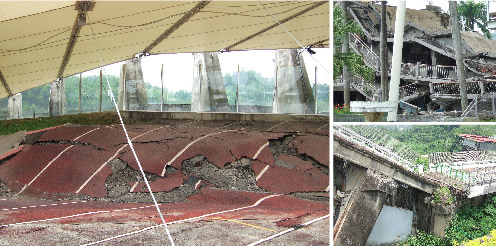Taiwan and Japan are located along stretch island arcs where four Plates of Pacific, Philippines, Eurasia, and North-American have complex conjunctions of subducting and overriding each other. Both countries have the highest level of seismic activities and suffered the destructive earthquakes recently. The 1999 Chi-Chi, Taiwan, Great Earthquake (Mw7.6) caused 2,415 deaths, 29 missing, and 11,305 severely wounded, with 51,711 buildings completely destroyed, 53,768 buildings severely damaged. The 2011 Great East Japan Earthquake (Mw9.0) caused 15,861 deaths, 6,107 injured, and 3,018 people missing across twenty prefectures, as well as 129,225 buildings totally collapsed, with a further 254,204 buildings 'half collapsed', and another 691,766 buildings partially damaged.

The oval tracks were moved 2.7m to S75W and uplifted 2.65m (left) by Chelungpu fault, buildings were destroyed (right top) in Guangfu Junior high school, and the Shigang dam was distorted and raised about 10 m (right bottom) during the 1999 Chi-Chi Earthquake.
Under the lessons learnt from the destructive earthquakes and the awareness of the unexpected earthquake possibly occur in the future, scientists on both sides have consensus of cooperative researches to share data, knowledge and information to mitigate the disasters.
The president of Committee of Taiwan Earthquake Model (TEM), Kuo-Fong Ma, and the director of Department of Socio-disaster research, NIED, Hiroyuki Fujiwara, agreed to hold the first workshop to share information on Probabilistic Seismic Hazard Assessment (PSHA).




